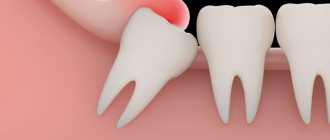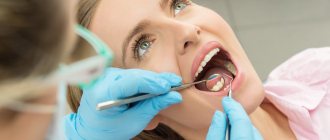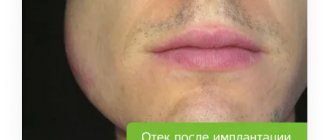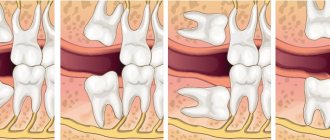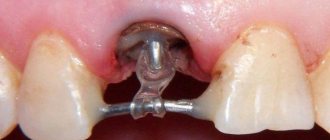Let's consider common questions that arise in patients with acute gum disease:
- How to treat an abscess on the gum in Samara
- What to do if pus appears on the gum
Moreover, precisely in this formulation. The definition of “abscess” in this case can include many different diseases, with different causes, mechanisms of development, different methods of prevention and treatment. The most common options will be discussed in this material.
Content:
- Why does pus come out of the gums?
- Signs indicating a problem
- Causes of pus discharge from the gums
- How do dentists treat pus in gums?
- Additional procedures to help get rid of purulent gum disease
- Recovery after treatment
- Is it possible to cure an abscess at home?
The presence of purulent exudate in the gum tissue is a dangerous symptom that should never be ignored. If it appears, you should immediately consult your dentist. Otherwise, the inflammatory process will progress, which will lead to damage to neighboring structures and premature tooth loss.
What treatment can be offered in dentistry?
If your gums near a tooth are festering, consult a doctor immediately. Do not try to solve the problem yourself, because such arrogance can lead to the development of even more severe and dangerous complications. After a visual examination and palpation, a specialist can refer you for x-ray diagnostics if necessary. After making an accurate diagnosis, the doctor will choose the optimal treatment tactics.
Surgical removal of purulent exudate
In advanced cases, the only option to solve the problem is surgical intervention. But first you must remove plaque and deposits. Next, under local anesthesia, the doctor opens the pathological focus and, if necessary, installs a drainage for the outflow of purulent masses. Then, after some time, you will need to visit a specialist again to remove the drainage system and apply sutures. After this, the doctor will prescribe appropriate medications for home therapy.
The photo shows an operation to remove pus
During rehabilitation, the patient must take prescribed anti-inflammatory drugs, including antibacterial rinses. If the gum is swollen near the tooth, and it is severely destroyed and there is serious damage to the root, it will have to be removed. In this case, the purulent abscess will be eliminated after extraction. It is also worth noting that in almost 60% of cases, such a picture is characteristic of problematic eruption of a wisdom tooth, and this is a strong indication for its removal1.
Drug therapy
If the pathological process is at a very early stage, it can be stopped without resorting to surgical intervention. But drug therapy is also prescribed after surgery. Thus, to remove pus and speed up tissue healing, experts in the field of periodontology prescribe the following drugs to patients:
- antiseptic solutions with anti-inflammatory effects, for example, Chlorhexidine,
- antibacterial and wound-healing gels and ointments - “Metrogil denta” or “Cholisal”,
- solutions for performing oral baths – “Stomatofit”, “Rotokan”,
- antibiotics to destroy pathogenic microflora - “Flemoxin Solutab”, “Ciprofloxacin” (only as prescribed by a doctor),
- painkillers – “Nurofen”, “Ketanov”,
- multivitamin complexes to strengthen the immune system - “Vitrum”, “Complivit”.
At an early stage of the disease, you can use ointments.
Almost each of the above drugs has its own nuances of use and contraindications. Therefore, you should undergo such therapy only according to a doctor’s indications.
Why does pus come out of the gums?
Suppuration is the result of infection penetrating into the deep tissues of the oral cavity. This is a kind of protective reaction of the body aimed at cleansing the affected area from a dangerous viral, bacterial or infectious agent.
As soon as pathogenic microflora begins to spread inside the gums, blood circulation there increases. Due to this, immune cells are faster delivered to the dangerous focus. As a result, the tissues become red, swollen, and painful to the touch.
Pus in the gums is dead microbes and dead immune cells. As its volume increases, an abscess forms.
What is a gum abscess, definition of the disease
Let us consider in more detail what an abscess on the gum is and the mechanism of its occurrence. A purulent focus occurs as a result of long-term untreated inflammation of periodontal tissues. The pathogenesis of the disease is associated with the penetration of pathogenic microorganisms (mainly Bacteroides forsythus and Porphyromonas gingivalis) into the periodontal tissues. Possible routes of penetration of microbes:
- from the outside: through a carious cavity, chips, cracks on the surface of the segment;
- from the inside (hematogenously, lymphogenously): in the presence of other septic foci in the body.
During their life, bacteria produce toxic substances that lyse tissue cells, resulting in the formation of a cavity filled with pus. The abscess under the tooth is surrounded by a connective tissue capsule, which separates it from the intact periodontal tissues.
Microbial metabolic products have a neurotoxic effect on nerve receptors located in the pulp of the segment, which causes pain. In addition, they increase the permeability of the capillary walls, resulting in swelling of the surrounding tissues.
Signs indicating a problem
A purulent neoplasm is difficult to miss. A person complains about:
- discomfort in the affected area, which intensifies with palpation, pressure, chewing food, and talking;
- unpleasant taste in the mouth (caused by periodic discharge of blood and necrotic masses from the abscess);
- tissue swelling;
- swelling of the cheek (indicates that the inflammation has gone very far and emergency dental care is required).
If the patient continues to ignore the symptoms, his health will worsen. His body temperature will rise, headaches and weakness will appear.
A violent inflammatory process will disrupt the dentogingival apparatus. Then the unit will become mobile and can fall out at any moment.
Reasons for the formation of bumps on the gums
To find out why a lump appeared on the gum, you need to make a correct diagnosis; only a specialist can do this. There are several reasons why swelling appears, but none of them are harmless. When diagnosing, the nature of the formation, color, density, presence or absence of pain, purulent exudate is taken into account, and the nature of the disease is clarified - infectious or other.
Important! Basically, most dental problems are associated with poor oral care. As a result, mucosal pathology develops with its own symptoms.
The reasons why a lump appears between the gum and cheek may be the following:
- irregular and illiterate oral care, resulting in infection affecting periodontal tissues;
- complications of untreated caries - infectious lesions of the roots (fistula, periostitis);
- periodontitis;
- complications resulting from dental implantation;
- improper wearing or manufacturing of orthopedic structures;
- cystic formations;
- gingivitis;
- periodontal trauma (hematoma);
- benign neoplasms (epulis, fibropapilloma);
- malignant tumors.
There is another reason for the occurrence of periodontal compaction. If a child has a white bump on his gum, this may indicate the eruption of a new tooth. Short-term swelling is not terrible, but if after a long time the tooth does not appear, you should consult a surgeon.
Attention!
Many are in no hurry to go to the doctor, since the growth does not hurt. The absence of discomfort does not indicate the absence of disease. Remember: if a lump appears on your gum, only a doctor will determine what to do and how serious the consequences will be!
Causes of pus discharge from the gums
The reasons for this phenomenon may be different. Let's name the most common ones:
- Periodontitis. The tip of the tooth root becomes inflamed. This is possible with advanced caries, poorly performed filling, or progressive pulpitis.
- Periodontitis. The dentogingival junction is damaged due to insufficient tissue nutrition, genetic predisposition, and reduced immunity. Food debris begins to accumulate in the resulting pockets, which leads to inflammation and suppuration.
- Gingivitis. Inflammatory gum disease. Bacteria begin to actively multiply due to poor hygiene and traumatic injuries. They penetrate the gums and cause suppuration.
- Periostitis. Chronic or acute inflammation of the periosteum of the jaw. It is the result of the spread of a dangerous infection through the bloodstream or through the lymph. It can also be a consequence of deep caries.
- Osteomyelitis. A purulent infectious-inflammatory process that covers various structures of the jaw and leads to necrosis of many tissues. Osteomyelitis can develop due to mechanical damage, spread of infection through the blood and lymph.
- Pericoronitis. Most often it has to do with a wisdom tooth that has not fully erupted. A voluminous hood of inflamed gums is formed over the unit, under which food accumulates. It serves as an excellent breeding ground for bacteria. Therefore, in the absence of adequate treatment, very soon a person notices that he is secreting pus.
As practice shows, most often pus in the gums appears due to cuts, injuries, or wearing incorrectly selected dental prostheses. Chronic gum damage triggers an inflammatory process that is difficult to stop. Therefore, it is important to pay attention to your oral health. If an inflammatory focus appears, it must be sanitized immediately. This will avoid many complications.
Stages of development and classification of gum abscess
A gum abscess most often has an acute course, characterized by a clear clinical picture with increasing pain and swelling. Sometimes, in the absence of treatment, the process may subside, the clinic becomes weakly expressed and erased. This means that the abscess has become chronic.
Depending on the location of the purulent focus, several types of pathology are distinguished:
- Periodontal abscess. Localized inside the hypertrophied periodontal pocket (between the alveolar process and the gum). The cause of the pathology is subgingival deposits, which are a breeding ground for the proliferation of bacteria.
- Periapical (root). The leading cause of occurrence is inadequate root canal treatment, leading to periodontal inflammation. Granulations form near the root apex. Progressive inflammation spreads to the periosteum and periodontal tissue. A connective tissue capsule with purulent contents is formed. Over time, a fistula forms with pus coming to the surface in the form of a lump.
- Desnevoy. The purulent cavity is located near the papillae between the segments. A possible cause is an injection into the gum.
How do dentists treat pus in gums?
Typically therapy includes the following steps:
- Survey. The doctor finds out when the purulent neoplasm appeared, how quickly it grows in size, and how it manifests itself.
- Examination of the oral cavity. The doctor studies the location of the abscess, its color, shape. If necessary, gives a referral for an x-ray of the affected side of the jaw. X-rays are needed to understand the condition of the internal structures.
- Removing food debris, stone and soft plaque from teeth and gums. Sanitation of the oral cavity before treatment of an abscess.
- Opening of a purulent neoplasm. Performed under local anesthesia. First, the patient is given an injection of anesthetic, and then the affected area is carefully dissected. As a result, purulent masses come out.
- Installation of drainage. To prevent exudate from beginning to accumulate in the gums again, a small drainage tube is installed into the incision. You need to walk with her for several days.
A mandatory stage of treatment is anti-inflammatory therapy. The patient is prescribed antibiotics and mouth rinses to prevent the recurrence of a purulent lesion.
It happens that pus is released when pressing on the tooth. In this case, there is no “bump” on the surface of the gum. In this case, the above scheme will be ineffective. The doctor removes the filling (if it was installed), cleans the dental canals and washes out all purulent accumulations. Places a special medicine and closes it with a temporary filling.
On the appointed day, the patient must come for a follow-up appointment. Then the doctor will assess whether the inflammation was removed. If yes, then he will replace the temporary filling with a permanent one; if not, he will re-place the anti-inflammatory composition in the canals and re-install the temporary filling material.
Treatment of gum abscess
Treatment of the disease is aimed at solving two main problems:
| Type of treatment | Methods |
| Symptomatic treatment of inflammation and pain syndrome | removal of an abscess on the gum (dissection, installation of drainage for the outflow of pus); antibiotic therapy (penicillins, fluoroquinolones, macrolides). Prescribed to stop the infectious process; NSAIDs (Diclofenac, Indomethacin, Ibuprofen, etc.). Eliminate pain and inflammation; antiseptics (Chlorhexidine, Miramistin). Used in the form of rinses and gum baths for antiseptic treatment of the oral cavity. |
| Etiotropic treatment (elimination of the cause of pathology) | tooth extraction. Carry out when it is impossible to implement tooth-preserving measures; repeated endodontic treatment (opening of canals and their refilling); professional teeth cleaning to remove mineral and soft plaque; removal of the artificial root (for peri-implantitis). |
An abscess on the gum is a serious dental pathology. If treatment is not started in time, the process continues to develop and leads to adverse consequences. To avoid complications, at the first signs of inflammation you should make an appointment with the dentist. ]dentistry in Otradnoye[/anchor] offers assistance in eliminating problems with diseased teeth and periodontal disease.
Recovery after treatment
After opening and draining the cavity, the body has to mobilize all its resources to speed up the healing process. To help him, it is important:
- comply with all medical prescriptions;
- take medications prescribed by the dentist;
- Healthy food;
- avoid stressful situations;
- dress according to the weather;
- quit smoking and alcohol;
- take a good vitamin and mineral complex;
- carefully monitor oral hygiene, include dental rinse, floss, and irrigator in your daily care.
How to diagnose a splinter in the gum or a bone from a fish
If a person feels discomfort in the mouth while at home, then you can try to detect a foreign body inside the gums yourself. To do this, you will need a mirror and a flashlight (you can use the flashlight built into your mobile phone).
Procedure steps:
- Wash your hands with soap and treat them with an antiseptic.
- Direct a beam of light into the oral cavity.
- Use a mirror to examine the location of discomfort.
- After the examination, it is recommended to rinse your mouth with a disinfectant (Chlorhexidine).
It is not always possible to independently detect a foreign body in the mouth. In this case, you need to go to the dentist's office to see a doctor. The dentist will perform a more thorough visual examination. Sometimes an x-ray may be necessary.
Is it possible to cure an abscess at home?
Doctors do not allow you to open a flux tumor on your own. This may lead to the addition of a secondary infection. If you are unable to visit a dental clinic in the coming days, you can alleviate the uncomfortable symptoms with the help of:
- Therapeutic and prophylactic rinses. When performing them, you need to use water at room temperature, salt and soda, and pharmaceutical antiseptics.
- Apply cold compresses to the sore cheek.
Under no circumstances should you heat the inflamed area. This will lead to activation of purulent-necrotic processes and the spread of infection, which is very dangerous.
Complications that a gum abscess can cause
Without treatment of the disease and inadequate medical care, complications may develop. Adverse consequences arise due to the spread of inflammation to neighboring organs and tissues, as well as the spread of infection throughout the body with the formation of secondary septic foci. The most common pathological conditions that occur are:
- lymphadenitis - infection of the lymph nodes;
- sinusitis - infection in the maxillary sinuses;
- periostitis of the jaw (inflammation of the periosteum);
- osteomyelitis of the jaw bones (destruction of bone tissue due to purulent-necrotic melting of osteocytes);
- phlegmon - diffuse odontogenic inflammation of soft tissues, accompanied by progressive swelling of the face;
- destruction of the alveolar processes with significant loosening of teeth or their loss;
- peri-implantitis with implant rejection;
- sepsis.
Purulent lesions of soft periodontal tissues are always accompanied by general intoxication of the body. The temperature rises and chills appear. There is a headache, tachycardia, and the pulse quickens. Pain relief with medications brings short-term relief, but symptoms return after the medication wears off.
Symptoms
This complication has very pronounced symptoms.
- Pain.
Many people perceive pain as a standard consequence of tooth extraction. This is partly logical, but over time the pain does not stop and only gets stronger. This is a clear sign of a complication. - Swelling and inflammatory process.
A tooth fragment injures soft tissues, causing swelling and inflammation. The longer you delay treatment, the stronger the inflammation. - A characteristic coating in the area of the hole.
Appears at a later stage, when the body tries to fight the inflammatory process. - Pus and bad breath.
A late stage complication that requires immediate intervention.
Other situations
Sometimes after tooth extraction a phenomenon called ecostosis occurs. After tooth extraction, the edge of the gum settles, causing part of the bone to protrude to the surface. Many patients may mistake a piece of bone for a tooth fragment. Ecostosis can be easily eliminated using the usual grinding procedure, so there is practically nothing to worry about in this case. Sometimes part of the bone material may come out of the hole, which is replanted with the patient before implantation if the height and volume of the native bone is not enough. Sometimes small pieces of bone material may come out through the sutures, but this is also not considered a serious complication.

